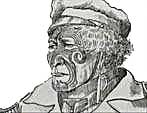Using
this new technology, he and his followers took control of land
throughout the Cook Strait region. They grew food and scraped
flax to trade for muskets, powder and tobacco.
He also wanted to control the supply of greenstone, and the
South Island, where greenstone was to be found, was open to
conquest as the tribes there had not yet acquired guns. Te Rauparaha
took war parties down to Kaikoura, Kaiapoia and Akaroa.
Te Rauparaha resisted European settlement in those areas he
claimed he had not sold. A major clash came in 1843 when Te
Rauparaha and Te Rangihaeata prevented the survey of the Wairau
plains. In the crisis that followed Te Rauparaha stayed on the
defensive. By avoiding war with the settlers, he contributed
greatly to its peaceful resolution.
 On
16 May 1846 there were again rumours of an imminent assault
on Wellington. The new governor, George Grey, decided that Te
Rauparaha could not be trusted and arrested him. The Ngati Toa
people never fully understood the reason for the warrior chief's
arrest.
On
16 May 1846 there were again rumours of an imminent assault
on Wellington. The new governor, George Grey, decided that Te
Rauparaha could not be trusted and arrested him. The Ngati Toa
people never fully understood the reason for the warrior chief's
arrest.
In January 1848 Grey finally released Te Rauparaha, after 18
months of imprisonment.
Te Rauparaha's son Tamihana obtained his father's release by
signing over the Wairau to Grey. Te Rauparaha died at Otaki
on 27th November 1849.
Summarised from the Dictionary of NZ Biography, and from Burns.
FULL
DNZB ARTICLE